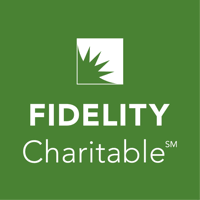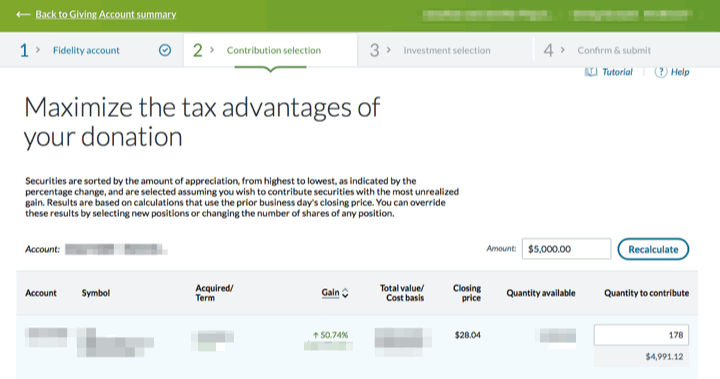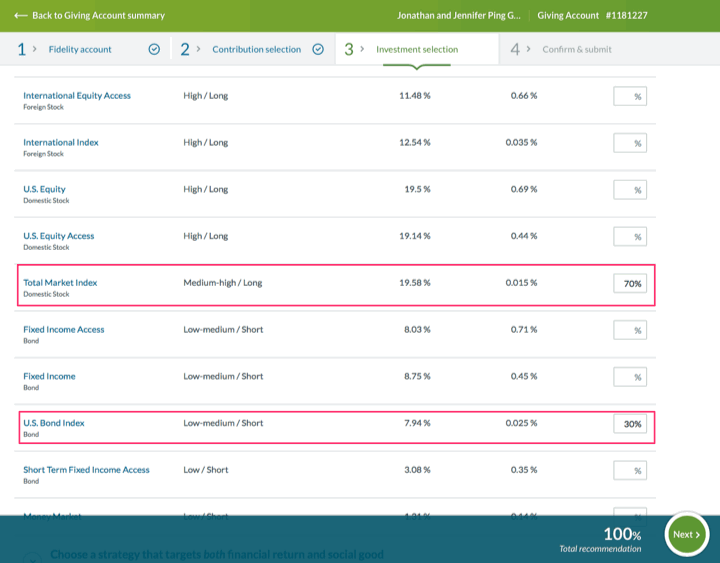
It took me an extra year to get around to it, but it only took me about 15 minutes to actually open and fund my new Fidelity Charitable Donor-Advised Fund (DAF). I even donated stocks instead of just cash, but the donating appreciated securities were from an existing Fidelity taxable brokerage account. Here’s a brief review of the process.
Step 1: Create Fidelity account. Provide personal details, including name, address, and Social Security Number. Similar to opening a new bank or brokerage account. They need this information for tax purposes. If, for example, you make 20 donations of $100 all to different charities, you will only have one $2,000 tax receipt at the end of the year. If you already have a Fidelity account log-in, it links easily.
Step 2: Contribution selection. If donating from a Fidelity brokerage account, they have a special tool that searches for tax lots with the largest unrealized gains. This maximizes the tax advantage of your donation. This ability to find specific lots is neat and overrides your usual default setting for tax lots (ex. First-in, First-out). You can also enter you desired donation amount and it will tell you how many shares you should donate to approximate that amount (final number will depend on market price). For now, I chose to donate enough to satisfy the minimum opening amount of $5,000. Here’s a screenshot:

Step 3: Investment selection. Pre-packaged or customized allocation. One of the benefits of a DAF is that you can invest your money in between the time of initial contribution and eventual distribution. I did not spend a lot of time agonizing over this choice, as I don’t plan on keep a large amount of funds in there. We are not talking about an obscene amount of money here, so I feel better about distributing it sooner and helping out now. I am mainly using the DAF for the bonus tax savings and thus making my effective contribution larger.
Still, I was happy to see that I could create a custom allocation using low-cost index fund choices, including a Total US Stock Market Index at 0.015% annual expense ratio and US Bond Index at 0.025% annual expense ratio. Keep in mind there is also a 0.60% annual administrative fee (minimum $100). I mostly hope that the market gains will more than offset the maintenance fees.

Step 4. Confirm and Submit. The overall user experience was smooth and my choices were summarized in a clear and concise manner. The actual sale of my shares will take a few business days. It is made clear that this is an irrevocable charitable contribution. This means I am eligible to take an itemized deduction for this contribution immediately.
You can also choose to donate stocks from an outside brokerage account, but that process will take more time (and possibly more work). I plan on trying this out later, to test out that experience.
 The Best Credit Card Bonus Offers – 2025
The Best Credit Card Bonus Offers – 2025 Big List of Free Stocks from Brokerage Apps
Big List of Free Stocks from Brokerage Apps Best Interest Rates on Cash - 2025
Best Interest Rates on Cash - 2025 Free Credit Scores x 3 + Free Credit Monitoring
Free Credit Scores x 3 + Free Credit Monitoring Best No Fee 0% APR Balance Transfer Offers
Best No Fee 0% APR Balance Transfer Offers Little-Known Cellular Data Plans That Can Save Big Money
Little-Known Cellular Data Plans That Can Save Big Money How To Haggle Your Cable or Direct TV Bill
How To Haggle Your Cable or Direct TV Bill Big List of Free Consumer Data Reports (Credit, Rent, Work)
Big List of Free Consumer Data Reports (Credit, Rent, Work)
With the new tax law it’s hard to take a deduction for charitable contributions. Will this help with that?
It can if you want to “bunch” your charitable contributions in a single year in order to qualify for the itemized deduction. You can contribute a higher amount upfront in a single year and grab that deduction, and then distribute it over multiple years.
This seems like a good approach. We funded a Fidelity DAF in 2018 (also with appreciated stock), planning just that – I.e. Fund a DAF and itemize once every 3-4 years, and in between, give from the DAF and take the standard deduction.
One caveat – there’s a cap on itemized deductions, computed from your Modified Adjusted Gross Income (MAGI), So a large donation might be capped, but you can carry it over to the subsequent year. For us, that meant carrying over some of our DAF-funding donation into 2019. So we’re giving ‘normally’ and itemizing this year to catch that carryover, and we’ll start using the DAF in 2020.
Thanks for this article, this is something we have had in mind due to the changes in the standard deduction, as you say here. It seemed like it might be kinda difficult to set up , so I’m glad to see at least one place where it is relatively easy.
One thing I have not seen in articles like this – and your companion one on giving appreciated stock – is that the IRS “wash sale” rules only apply to stocks sold for a loss. So if you have a stock that has appreciated in value that you would like to keep, you can take advantage of this tax break and repurchase the stock without problems with the rules.
Why not use Vanguard for DAF?